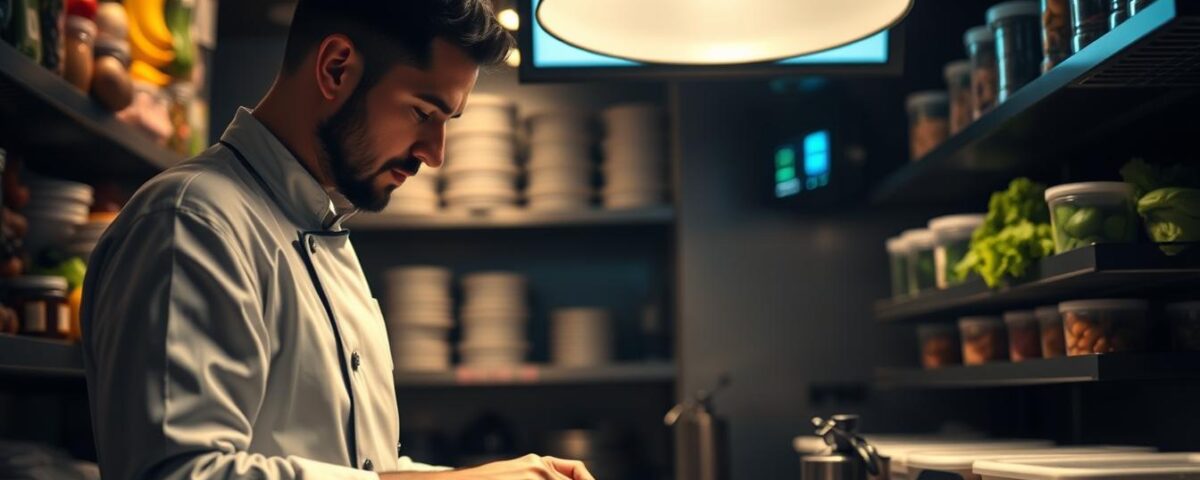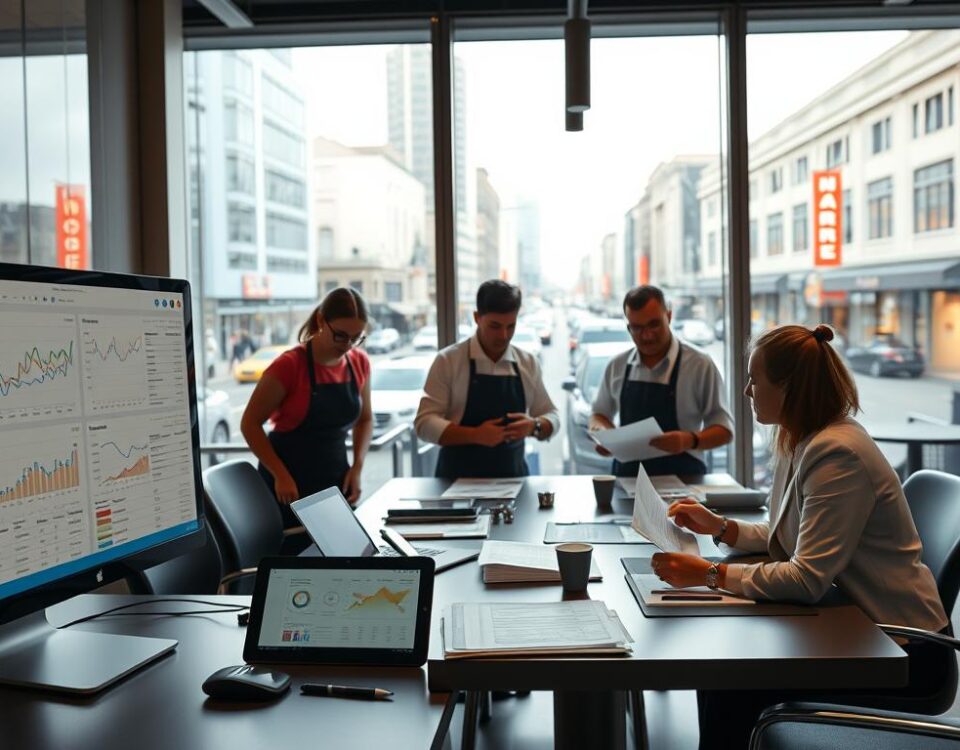
Quick Calculator: Find Your Food Cost in Under 5 Minutes
August 23, 2025
Should You Add Kiosks? How They Boost Orders Without Hiring
August 24, 2025I still remember the day I realized how much food waste was silently killing my restaurant’s profits. It was a wake-up call that led me to discover a game-changing solution: restaurant waste reduction software. This innovative technology has been a lifesaver, helping me save thousands of dollars annually while reducing my environmental footprint.
The scale of food waste is staggering. The EPA estimates that more food reaches incinerators and landfills than any other single material in our everyday trash, constituting a whopping 22 percent of discarded municipal waste. For restaurants, this translates to billions of dollars in potential profits being thrown away.
By leveraging waste reduction solutions, restaurants can identify waste patterns, optimize inventory, and transform kitchen operations. The result? A significant cut in food waste and a direct improvement to the bottom line. As someone who’s seen the benefits firsthand, I’m excited to share how this technology can revolutionize the way restaurants manage their kitchen operations and impact the environment.
Key Takeaways
- Restaurant waste reduction software helps save thousands of dollars annually.
- Implementing waste reduction solutions can significantly reduce environmental impact.
- These solutions identify waste patterns and optimize inventory.
- Transforming kitchen operations can dramatically cut down on food waste.
- Reducing waste directly improves a restaurant’s bottom line.
The Staggering Cost of Food Waste in Restaurants
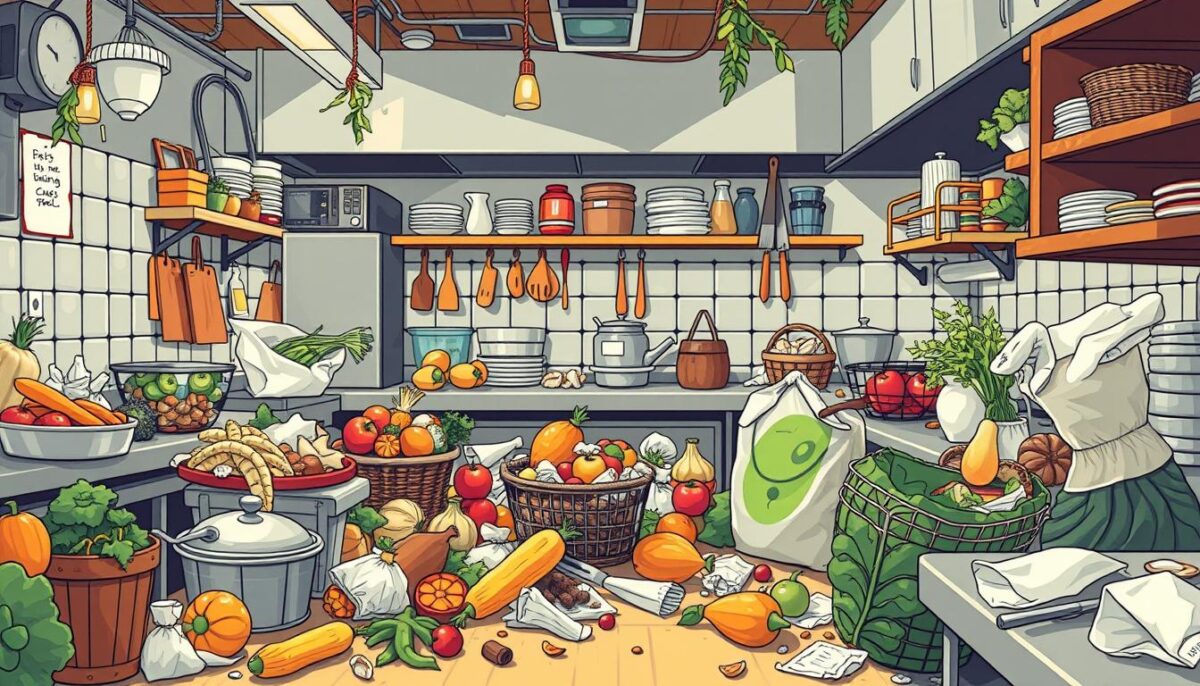
The alarming rate of food waste in restaurants is a staggering issue that affects not only the bottom line but also the environment. According to the United Nations, 17% of the world’s total food production is wasted every year, amounting to 1.03 billion tonnes of wasted food.
This staggering statistic highlights the significant impact of food waste on the environment, contributing to greenhouse gas emissions and resource depletion. In fact, if food waste was a nation, it would rank as the third highest national emitter of greenhouse gases after the US and China.
Here are some key insights I’ve gained from understanding food waste in restaurants:
- I was shocked when I first saw the data on how much food waste costs my restaurant each year – it’s not just the food cost itself but also the labor, utilities, and disposal expenses.
- The average restaurant wastes up to 10% of purchased food before it even reaches a customer, representing thousands of dollars literally thrown away every month.
- Beyond my bottom line, I’ve learned that restaurant food waste has a staggering impact on the world’s sustainability efforts, contributing significantly to greenhouse gas emissions and resource depletion.
- I’ve discovered that tracking waste over time provides invaluable insights that help me make better purchasing decisions and improve kitchen efficiency.
- Reducing food waste isn’t just good business – it’s becoming essential as consumers increasingly support restaurants that demonstrate environmental responsibility.
By understanding the true cost of food waste, restaurants can take the first step towards reducing their environmental impact while improving their bottom line.
How Restaurant Waste Reduction Software Works
![]()
The key to minimizing waste lies in understanding how restaurant waste reduction software operates. This technology is a game-changer for restaurants looking to reduce food waste and optimize their inventory management.
I’ve found that modern restaurant waste reduction software creates a complete digital ecosystem that tracks every aspect of my food inventory and usage patterns. The solution collects valuable data at multiple points – from receiving deliveries to preparing dishes to tracking what gets thrown away.
- The software integrates with my point-of-sale system to compare what’s being ordered against what’s being purchased, helping me reduce food orders to match actual demand.
- I can now identify patterns that were previously invisible, like which ingredients consistently spoil before use or which menu items generate the most prep waste.
- What impresses me most is how these platforms transform complex data into simple, actionable recommendations that my entire team can understand and implement to reduce waste.
By leveraging this technology, restaurants can gain insights into their operations and make informed decisions to minimize waste and improve their bottom line.
Smart Inventory Management: The First Step to Reducing Waste

By leveraging advanced inventory management, restaurants can take the first step towards substantial waste reduction. This approach not only streamlines operations but also significantly cuts down on unnecessary expenses.
Real-Time Tracking and Alerts
With real-time tracking, I can monitor my inventory levels as they change. This feature allows me to receive alerts when stock levels are low, ensuring I never run out of essential ingredients. As a result, I can avoid last-minute orders and reduce the risk of over-ordering, which directly contributes to reducing food waste.
Automated Ordering Based on Usage Patterns
Automated ordering has been a game-changer for my restaurant. By analyzing historical usage patterns, the software adjusts quantities accordingly, taking into account factors like seasonality and upcoming reservations. This means I can confidently order just what we need, minimizing the likelihood of throwing out unused food at the end of the week.
Some key benefits I’ve experienced include:
- Eliminating guesswork from my ordering process with automated analysis of historical usage patterns.
- The software examines factors like seasonality, reservations, and weather forecasts to predict our weekly needs.
- Seeing significant results within just a few weeks, with a nearly 30% drop in food waste from over-ordering.
- The system adjusts for market fluctuations, suggesting alternatives when ingredients are out of season or overpriced.
- Confidently ordering based on data-driven recommendations rather than the “order extra just in case” mentality.
Waste Tracking: Identifying Problem Areas in Your Kitchen
![]()
Implementing food waste tracking software has revolutionized how restaurants manage their kitchen waste. By closely monitoring waste patterns, restaurants can identify areas for improvement.
Detailed Waste Reports and Analytics
The software provides detailed waste reports, giving insights into the types and amounts of waste generated. This data is crucial for making informed decisions about waste reduction.
Connecting Waste to Financial Impact
Users have reported significant benefits from using the software, including:
- Translating waste data into financial terms, showing exactly how much money is wasted daily.
- Calculating the true cost of waste, including labor, utilities, and disposal expenses.
- Achieving five-figure savings over a year through small efficiency improvements.
- Having more productive conversations about waste with the team, as the financial impact is clear.
- Running “what if” scenarios to estimate the financial impact of potential changes.
Since food costs usually account for 28-35 percent of restaurant sales, dealing with food waste can make a substantial difference in profitability.
Menu Engineering and Recipe Management
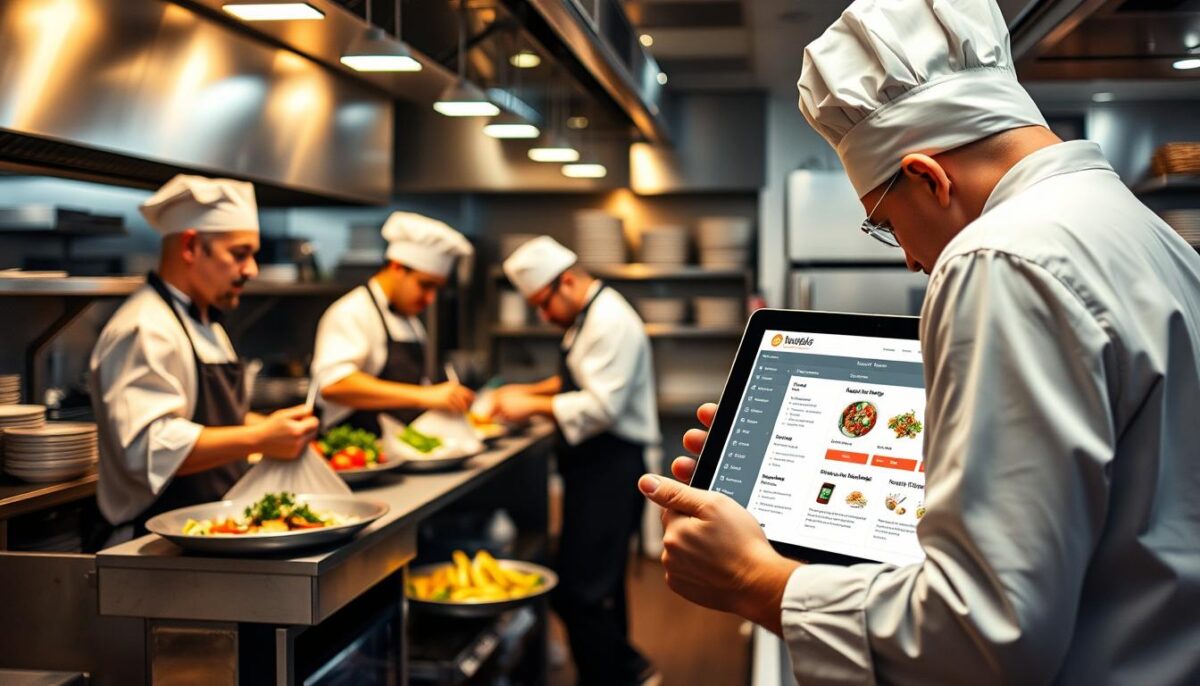
Restaurant recipe management software is a game-changer for minimizing waste. By optimizing menu items and managing recipes effectively, restaurants can significantly reduce food waste. This software helps in creating a more streamlined kitchen operation.
Portion Control and Recipe Standardization
Standardizing recipes and controlling portion sizes are crucial for reducing waste. With recipe management software, chefs can access standardized recipes, ensuring consistency across dishes. This not only reduces food waste but also enhances customer satisfaction by providing consistent taste and quality.
Cross-Utilization of Ingredients
Cross-utilization of ingredients is a powerful tool for reducing food waste. The software helps identify ingredients used in multiple dishes, suggesting creative ways to incorporate them into other menu items. For instance, if radishes are primarily used in one salad, the software can suggest alternative recipes like tacos or appetizers, ensuring that the ingredient is used before it spoils.
Some key benefits of cross-utilization include:
- I’ve discovered that cross-utilization of ingredients is one of the most powerful tools for reducing food waste in my restaurant.
- The software helps my team identify ingredients that are only used in one dish (high waste risk) and suggests creative ways to incorporate them into other menu items.
- What’s been game-changing is how the system flags “orphaned ingredients” – those that might be left unused after a specific dish is removed from the menu.
- I can now design my menu as an interconnected ecosystem where trim from one dish becomes an ingredient for another, maximizing the use of every product we bring into the kitchen.
- The recipe suggestion feature has sparked creativity among my culinary team, challenging them to develop new dishes specifically designed to utilize potential waste items.
Seasonal Planning and Vendor Management
Seasonal planning and vendor management are key strategies for restaurants aiming to reduce food waste and improve their bottom line. By adapting to seasonal changes and managing vendors effectively, restaurants can streamline their operations and minimize waste.

Adapting Your Menu to Seasonal Availability
With MarketMan, you can easily adjust your menu according to seasonal availability, ensuring that you’re always offering fresh and relevant dishes. This not only reduces food waste but also keeps your menu exciting for customers.
Streamlining Communication with Suppliers
The restaurant supplier management software allows for seamless communication with vendors, reducing order handling time and improving overall efficiency. Your team can set standing orders that adjust based on inventory levels and usage patterns, making it easier to manage multiple suppliers simultaneously.
By leveraging this solution, you can compare supplier offerings in real-time, making agile decisions as market conditions change week to week.
Beyond Cost Savings: Sustainability as a Marketing Tool
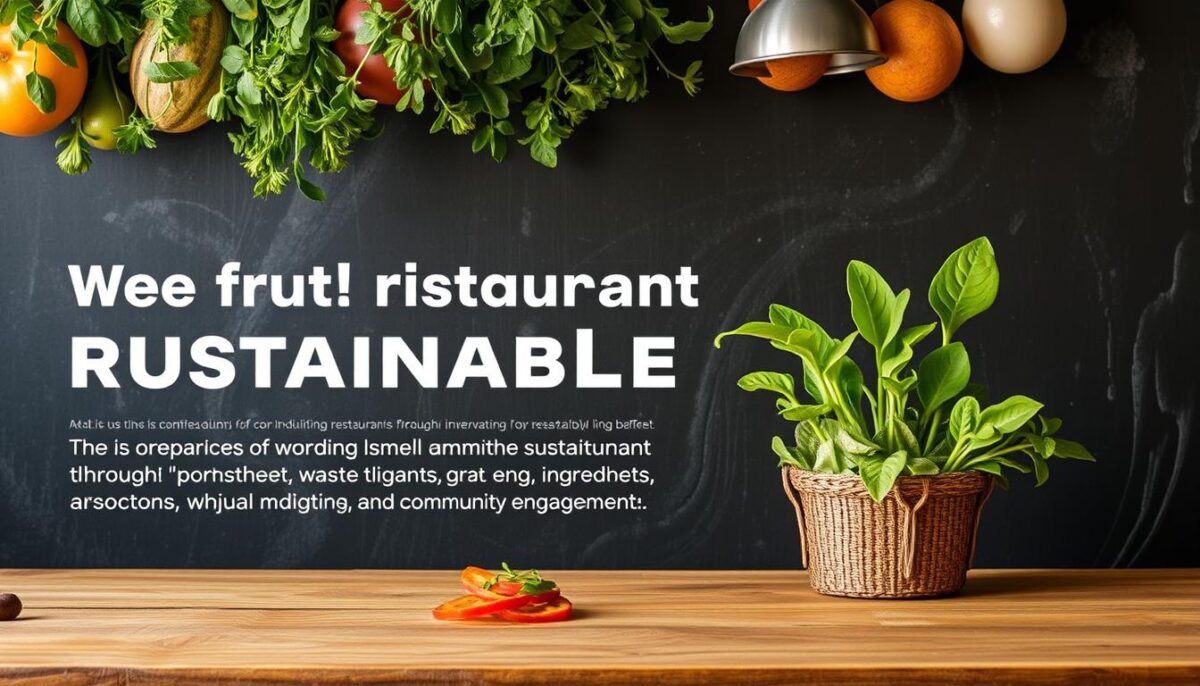
The benefits of reducing food waste in restaurants extend far beyond cost savings, offering a unique marketing opportunity. By embracing sustainability, restaurants can attract a loyal customer base that values eco-friendly practices.
Here are a few ways that reducing food waste has become a marketing advantage for my restaurant:
- I’ve discovered that my restaurant’s waste reduction efforts have become a powerful marketing advantage in today’s environmentally conscious world.
- The software provides verified sustainability metrics that I can share with customers, demonstrating our concrete actions rather than just making vague claims.
- What’s been surprising is how many people specifically mention our sustainability efforts in reviews and when choosing our restaurant over competitors.
- I can now quantify our environmental impact in terms that resonate with customers – like equivalent trees saved or emissions reduced – making our sustainability story more compelling.
- The data shows that restaurants with strong sustainability programs are seeing increased customer loyalty and willingness to pay slightly higher prices, making waste reduction a true win-win for business and the environment.
By highlighting our commitment to sustainability and reducing food waste, we not only contribute to a healthier environment but also enhance our brand reputation and appeal to customers who share our values.
Conclusion: Transform Your Restaurant Operations Today
I’ve seen firsthand how restaurant waste reduction software can transform kitchen operations from a source of constant waste to a model of efficiency and profitability. By leveraging tools like MarketMan, restaurateurs can automate inventory management, control food costs, and streamline back-of-house processes effortlessly.
Reducing food waste by more than half is achievable, and it simultaneously improves food quality and consistency. The solution is accessible for restaurants of all sizes, making waste reduction achievable for every food service business ready to embrace success through sustainability. Take the first step today by analyzing your current waste patterns and discover the potential savings hiding in your kitchen.
FAQ
How can I start reducing food cost in my kitchen?
To start reducing food cost, I recommend implementing a smart inventory management system that allows you to track your ingredients in real-time and receive alerts when they’re running low. This helps prevent overordering and reduces the likelihood of expired or spoiled ingredients.
What is the most effective way to track food waste in my kitchen?
I find that using a detailed waste tracking system is the most effective way to identify problem areas in your kitchen. This system provides insights into the types and quantities of waste generated, allowing you to make data-driven decisions to minimize waste.
How can I make my menu more sustainable?
To make your menu more sustainable, consider menu engineering and recipe management techniques, such as portion control and recipe standardization. This helps reduce food waste and ensures that you’re using ingredients efficiently.
Can reducing food waste really impact my bottom line?
Yes, reducing food waste can have a significant impact on your bottom line. By minimizing waste, you can reduce food costs and improve your overall efficiency in the kitchen.
How do I communicate with my suppliers more effectively?
To streamline communication with your suppliers, I recommend using a vendor management system that allows you to place orders and track deliveries in real-time. This helps prevent miscommunication and ensures that you’re receiving the ingredients you need on time.
Is reducing food waste a marketing opportunity?
Absolutely, reducing food waste can be a valuable marketing tool. By highlighting your commitment to sustainability, you can attract customers who share your values and improve your brand reputation.
